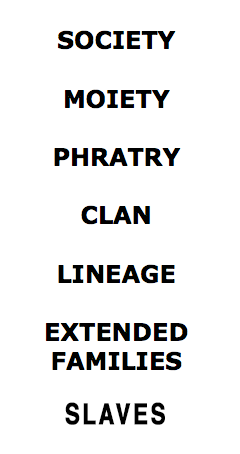
| ||
Cannibal Woman, a Tale Told at the Willows |
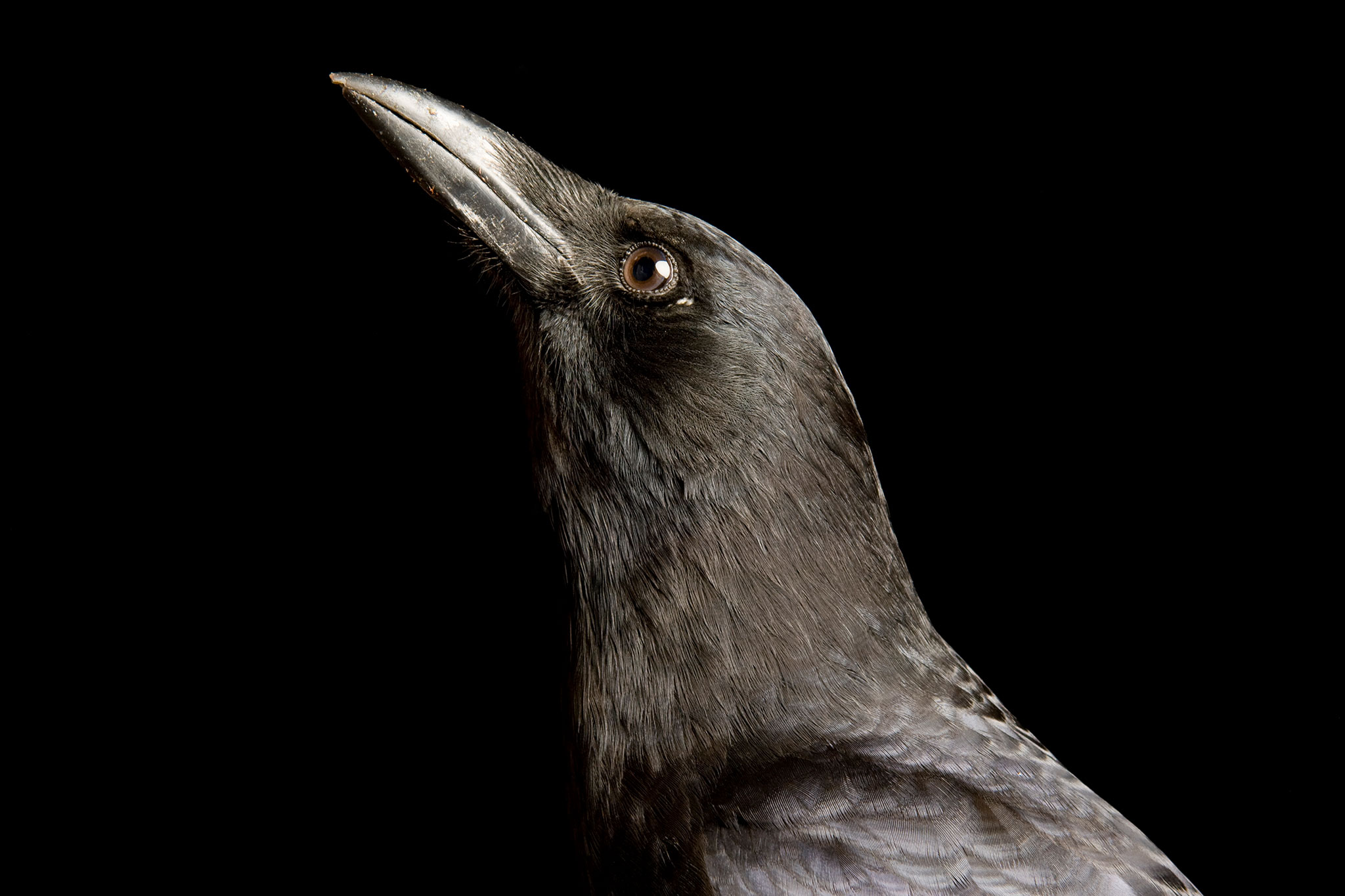 |
|
Among the First Nations of the Northwest Coast, the Raven is the primary generative force in the world, a curious trickster who has shaped nearly every aspect of human society and behavior. He coaxed human beings from a clamshell on the beach, caused the tides, set the sun free, and separated the day and the night. He is at the heart of the story we are telling today - the fate of Cannibal Woman and how the Cannibal Woman Society is at the heart of the Winter Ceremonials and the potlatch system of the Kwakiutl, or Kwakwaka'wakw, and their neighbors. |
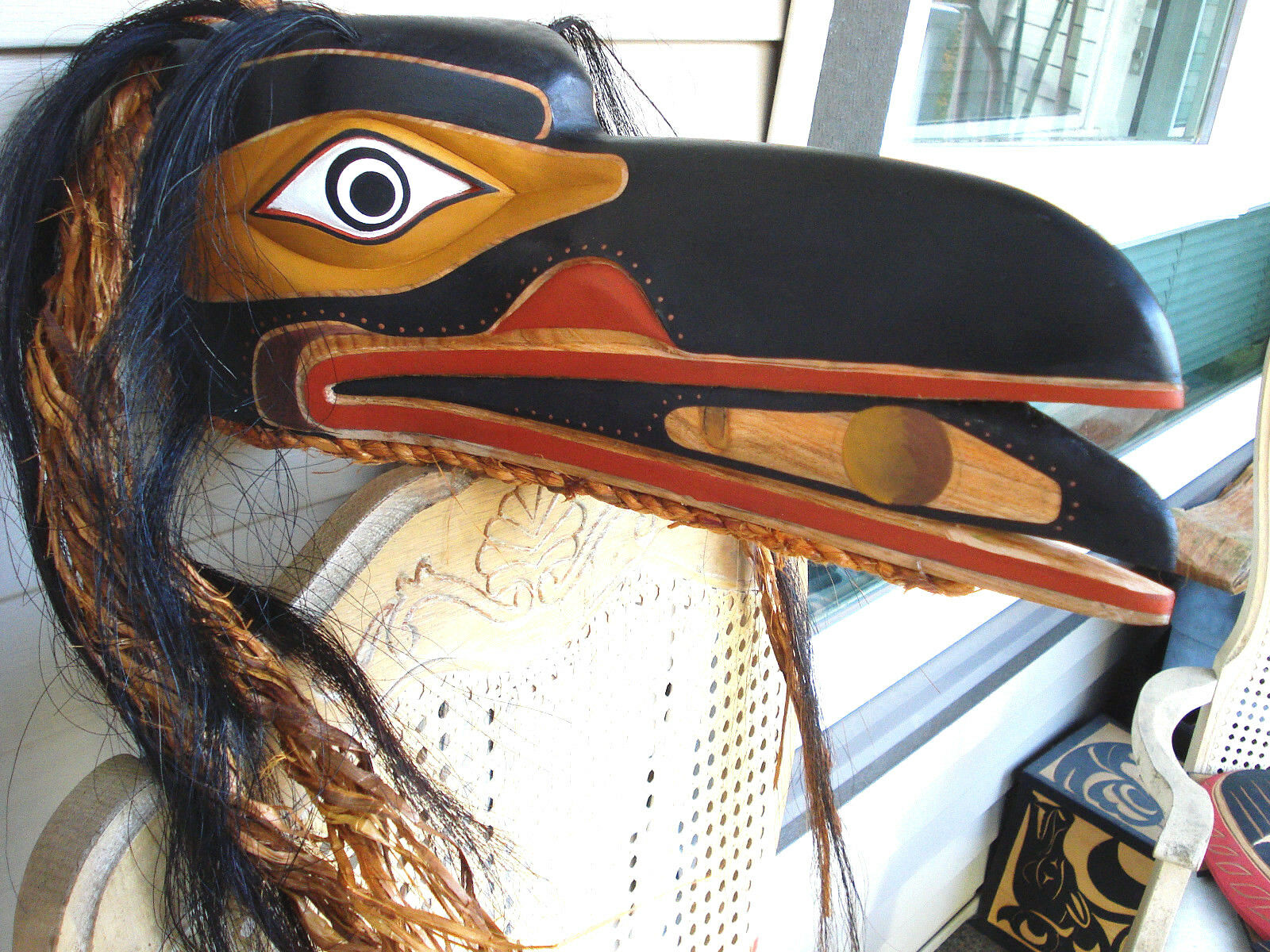 |
|
Raven takes on many guises in the world and in also in Northwest Coast art. Many of his special powers come from his gift of speech, made possible by his jointed tongue. This mask, carved in 2018 by Janice Morin, clearly shows the joint hidden within his tongue. Notice the red cedar in the hair and beneath the beak. This sign lets everyone know that this particular representation of Raven is a Hamatsa Mask depicting Raven as the leader of the Cannibal Birds. This is Raven's Hamatsa persona, Hamatsa being the Cannibal Woman Society. The tale we consider today is of Raven the Cannibal, leader of the fearsome Cannibal Birds, who sport colorful names such as Splitter of Skulls. |
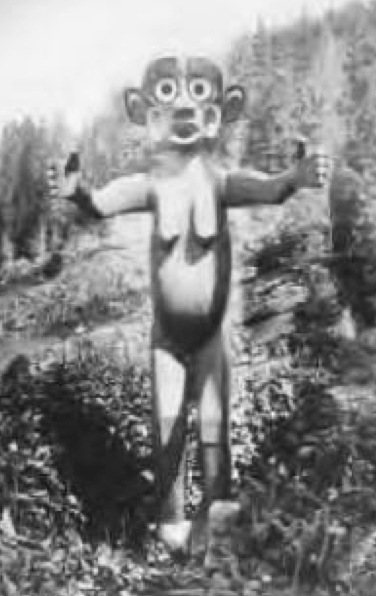 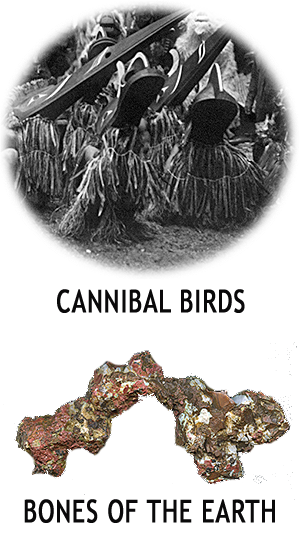 |
|
Long ago when totemic beings walked abroad in the world, there was one called Dzoonokow, or Cannibal Woman. She was gigantic, with wealth and powerful magic, and the unfortunate habit of eating people of all kinds. The totemic beings became alarmed, fearing that Cannibal Woman might eat them. Raven, they decided, was the only one among them that might be able to restrain Cannibal Woman. But how? Raven flew up to the North End of the World and there recruited and became the leader of a flock of fearsome Cannibal Birds. He took his flock back south to the great forest and Cannibal Woman, where they danced and sang her praises. But when the dance ended, Cannibal Woman found that she had been bound by a powerful magic and could no longer eat flesh. The only things she could eat were the bones of the earth, which are nuggets of native copper. |
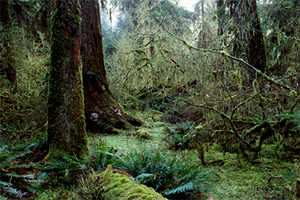 |
The spirit of Cannibal Woman lives on the great forests of the Pacific Northwest. She still craves flesh but cannot eat. But, through her magic, she can ensnare humans and turn them into cannibals and so taste of human flesh through them. Is your child becoming antisocial? Spend lots of time in the forest, especially at night. Sullen? Noticed staring strangely at people? Your child may be falling under the spell of Cannibal Woman. You need to consult a shaman. |
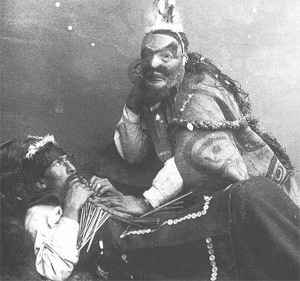 |
Shamans are fearsome beings who live both in this world and the spirit world. They are feared and respected. When called in to diagnose or heal a person, they often reveal startling truths. A young man with physical and mental problems might be found to be the victim of witchcraft, guilty of a crime, or supernatural possession by a spirit. If he is found to be possessed by Cannibal Woman, he is turned over the Cannibal Woman Society to be cured. Staged photograph by Edward De Groff of a Tlingit Shaman curing a sick man, taken in Sitka in 1889. |

Here we have members of the Cannibal Woman Society posing in their Hamatsa dance costumes. On the margins and in the background are some of their helpers in the winter ceremony drawn from other secret societies and given special tasks. The Cannibal Woman Society is secret in the sense that its special knowledge and many of its rituals remain secret. Everyone knows the members of the society and understands the dances, songs and rituals that they conduct openly during the winter ceremonial celebration. These performances are at the heart of Kwakiutl spiritual beliefs and essential to the well being of their nation. As such, members of the Cannibal Woman Society are among the most highly respected members of the Kwakiutl Nation. To become a member of the Society, you must be selected as an Initiate and go through a long period of training. Initiates may inherit the right or they may be selected because they have been possessed, and so selected, by Cannibal Woman. |
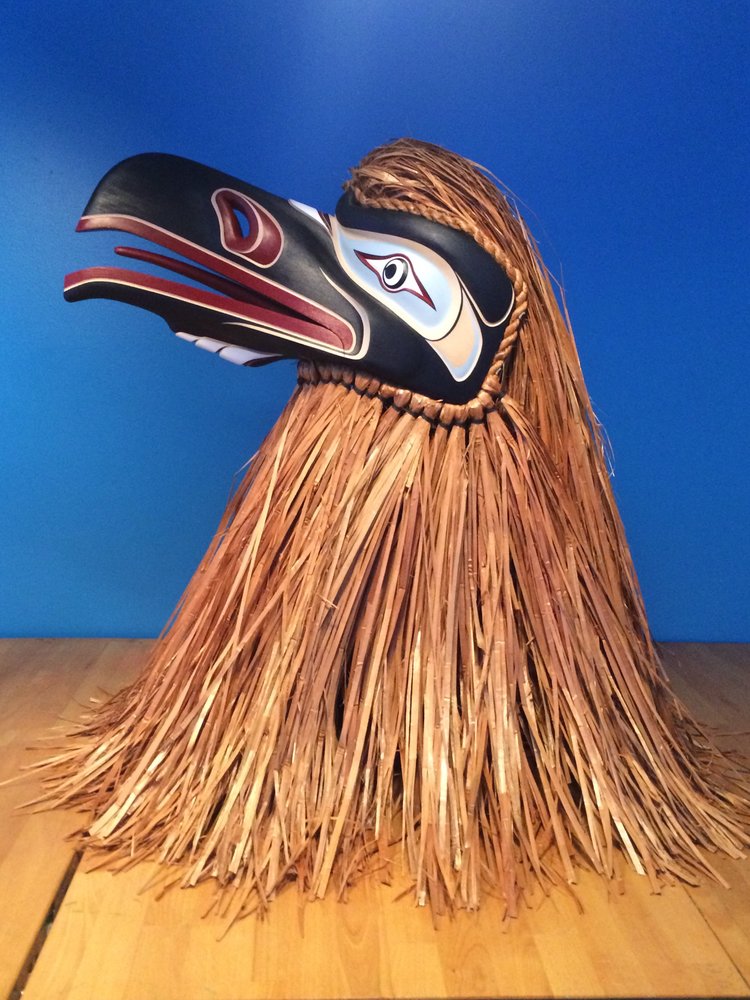 |
|
Modern Hamatsa Society Raven mask. |
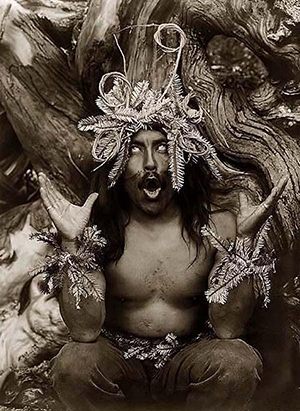 |
JOURNEY OF THE INITIATE DIAGNOSIS ISOLATION EMERGENCE CEREMONY ACCEPTANCE EMERITIS The initiate assumes many roles within the annual ceremonial round of the Hamatsa Society. He begins as the central focus of the Hamatsa Winter Ceremony. This photo depicts the initiate in just one of his manifestations, as staged by Curtis in 1914. |
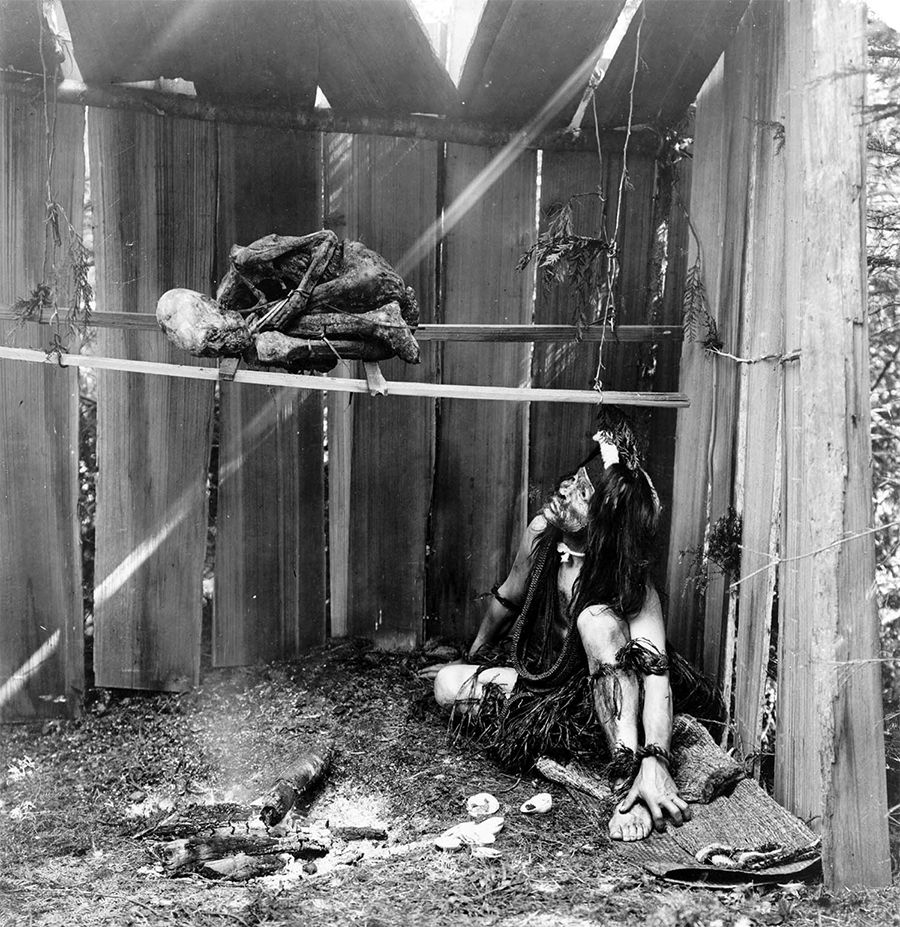 |
The first stage is to make the initiate into a virtual cannibal. He is isolated in a small shack in the woods. What happens there is secret, but a little was revealed in 1910 in this staged photograph showing an initiate in a drying shed with a human body that is being smoked and mummified. |
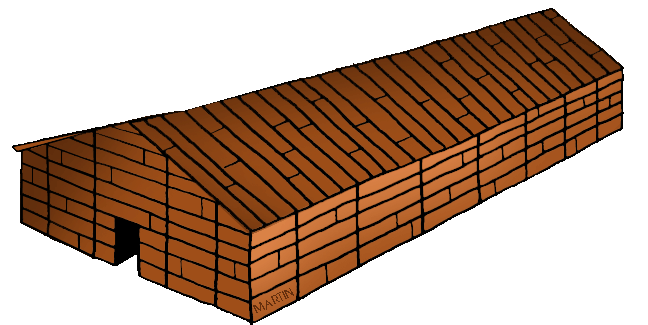 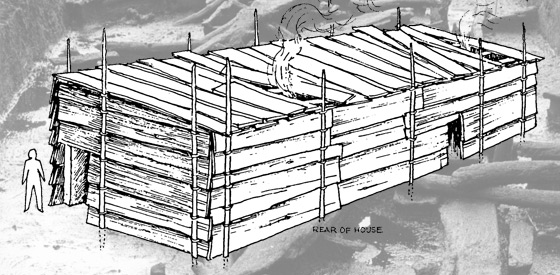 |
|
After the initiate had been turned into a cannibal, he was held until the winter ceremonial celebration began. He then emerged dramatically and attempted to attack and bite people. He might come in through the rear door of the great long house in which the ceremonials were held, or he might climb to the roof, throw back a plank and drop to the dance floor below. The images above show very simplified drawings of a long house and movable roof planks. |
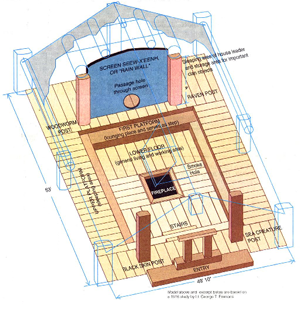 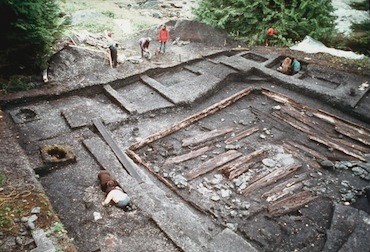 |
|
The great clan long houses in which winter ceremonials were held were huge. The Tlingit Whale House, on the left, was 55 feet long and more than 40 feet wide, with a high roof and platforms for dignitaries and onlookers. On the right is shown the excavation in progress of a Tsimshian long house. Notice the men standing along the periphery at the back of the house. |
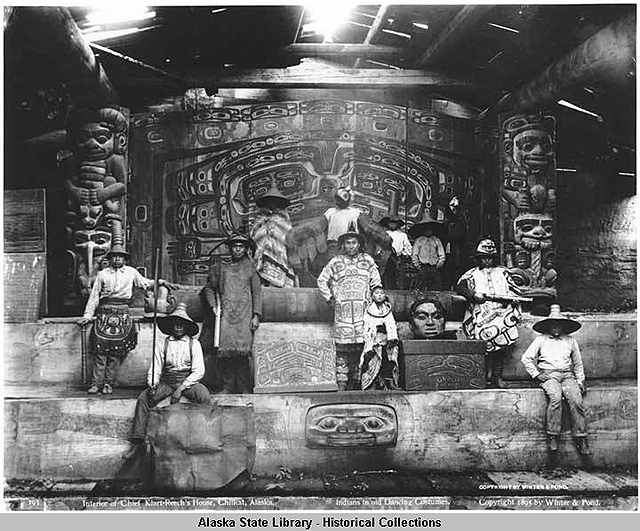 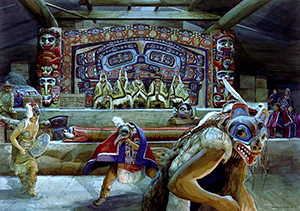 |
|
On the left, you see the interior of Whale House with clan leaders posing in informal attire in 1885. On the right, you see an artists visualization of Whale House with dancers performing. Here, the clan chiefs are formally attired in their chilcat blankets, which denote clan history and rank. |
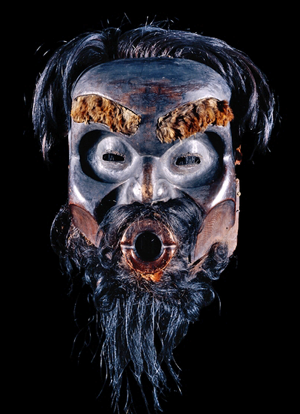 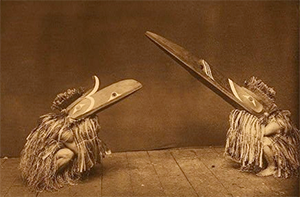 |
|
The initiate arrives in the great house as Cannibal Woman, and is made to ware her mask and cry out in her voice. At the left is a Kwakiutl Dzoonokwa Mask (British Museum, 19th Century). The eye-slits are elongated and the mouth is a deep tube. The eyes are covered from the inside with hair, so the dancer is blind. The Hamatsa dancers surround him closely and their rhythm guides his feet. Although Dzoonokwa is a woman, her features are very masculine. Admission to the Hamatsa Society is limited to men, so it is men that appear as Cannibal Woman in the Winter Ceremonies (Tsetsequ or Tseka) and at Potlatches. The word "Tsetsequ" implies imitation, double meanings, trickery, deceit, hidden meanings, and deep things obscured by surface appearances. Cannibal Woman embodies this idea and is the most important figure in the Winter Ceremonies. The Cannibal Woman is immediately surrounded by the cannibal bird dancers who include Raven and Hok Hok (photo right). |
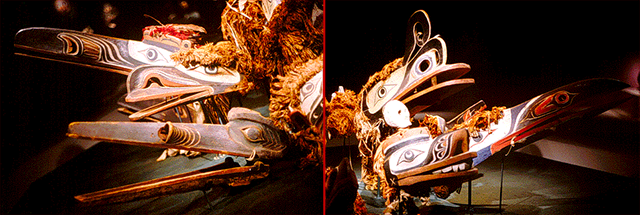 |
|
The Gwa'wina Hamsiwe' are the "assistants" of Baxwbakwalanuxwsiwe (Cannibal Woman). There's quite a flock of them, including a fearsome manifestation of Raven, who is their leader. On the one hand, they all have cannibalistic natures and fearsome names and reputations. But on the other, they are also the ones who bind Cannibal Woman, placing her power at the disposal of humans through the Hamatsa Society and the lineages of powerful chiefs. This group of Hamsiwe' masks was acquired by the Heye Foundation for display in its Museum of the American Indian. Most date from about 1890 to 1910. |
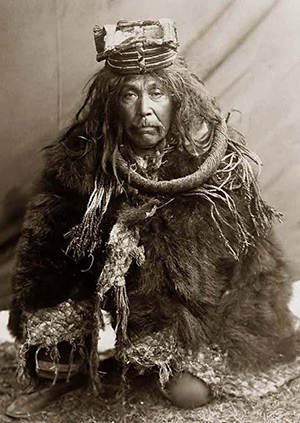 |
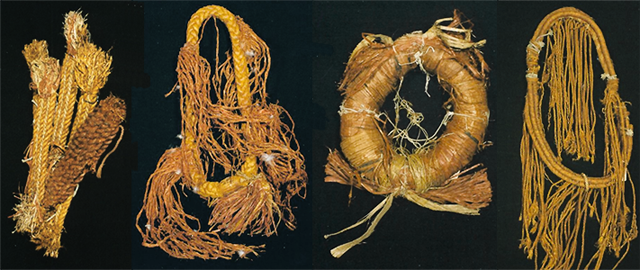
The dance to tame the initiate and drive out the spirit of Cannibal Woman is done in stages over four or more days. The songs, dances, and contume of the Initiate change from stage to stage, as Cannibal Woman withdraws and the initiate becomes more and more human. To the left, you see a 1914 photograph taken by Curtis that shows the initiate after the first round of dancing. Above, are examples of costume elements. Each has a particular meaning that evokes an aspect of the ceremony or a particular part of the story it tells. Notice, these are all made of red cedar the use of which is always connected with Cannibal Woman and the Hamatsa. |
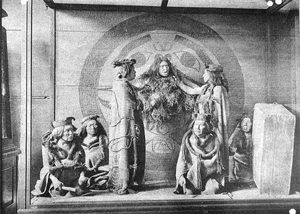 |
In this diarama created by Franz Boas at the American Museum of Natural History, the Hiligaxste' draw out the Hamatsa Initiate through the screen at the back of the long house. Female relatives of the initiate sit on either side of the portal. This is later in the dance cycle as the invluence of Cannibal Woman on the initiate is receding. |
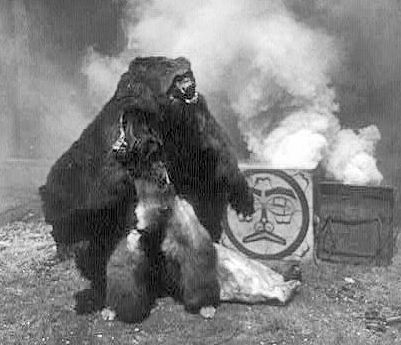
|
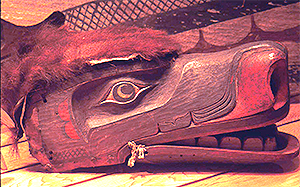
|
|
As the dance procedes day by day, the Cannibal Birds play a diminished role and are replaced by the Hiligaxste', who are drawn from other important Secret Societies and Clans. One of these is the Grissly Bear Society, one of whom you see dancing at the left (Kwakiutl, image by Curtis, 1910-1914). To the right is a Grissly Bear forehead mask (Kwakiutl, ca 1880-1900, Field Museum). | |
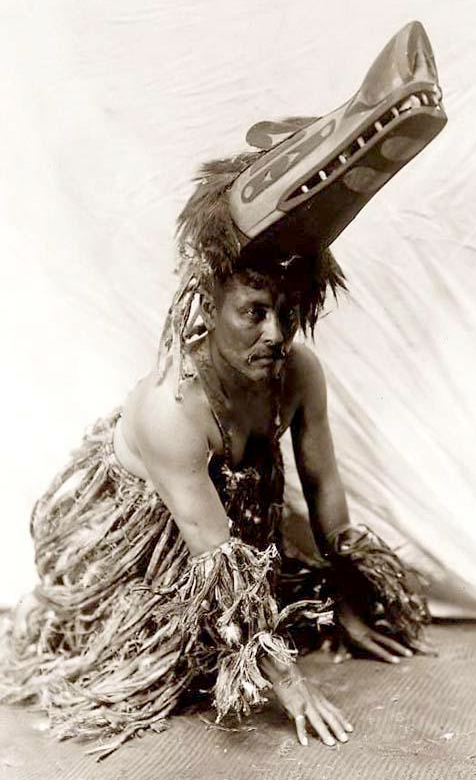
|
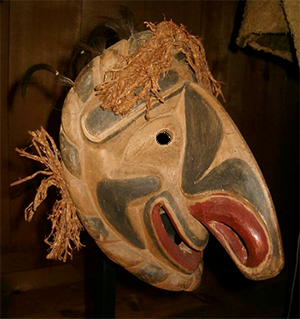
|
|
Here are two other helping societies. At the left, a Wolf Society (Walas'aka) dancer with a forehead mask poses for Curtis (1910-1914) in his dance regalia. At the right, is a Fool Society mask. Fools help keep the peace with sticks and stones, but were also armed with more serious weapons. They might also run amok breaking property, which they had to replace after the winter ceremonies concluded. Their noses produced vast amounts of snot that they would spread on those around them. | |
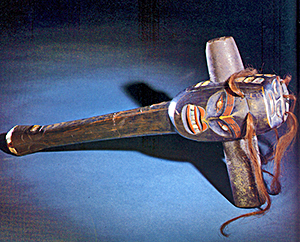 
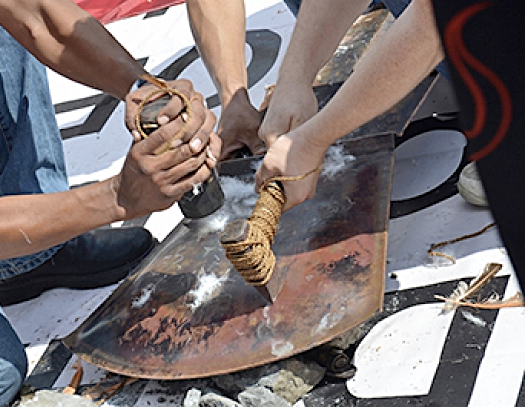
|
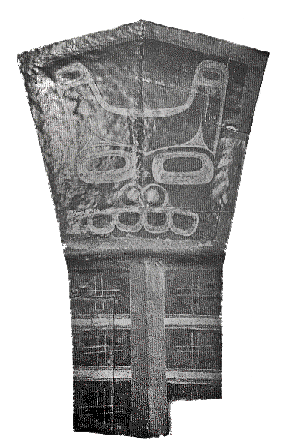
|
|
The dance cycle concludes when the initiate, still in the guise of Cannibal Women, is made to break a copper by cutting one of it's corners away. The copper is made from the bones of the earth, which Cannibal Woman is forced to eat. The copper is also an extremely valuable object. When cut by the Initiate at the end of a Potlatch, it looses its value. The copper at the right is one in the UBC collection. Above are two copper breakers, or K'aldayu. The one on the right is topped by an carving of Cannibal Woman. Note that the mouth is cardved all the way through just as it would be on a mask. These are struck with heavy, stone hand mauls in order to cut through the copper. Coppers have many uses. At the lower left, Kwakiutl Chief Beau Dick breaks a copper on the steps of the BC Provincial Legislature in 2013 in order to shame the legislature and the people of British Columbia. Notice that iron is now employed for both the hand maul and the K'aldayu. | |
|
Only a few Northwest groups have moieties or phratries. In the past, the Kwakiutl had clans, lineages, extended families and slaves. Name, rank and most important property was passed down through the male line. Social hierarchies are most complex at the heart of the Northwest Coast. They become less complex rapidly as you move to the north, south and west. This pattern corresponds roughly to population density, and to the stability and abundance of resources. |
| TOP Home | |
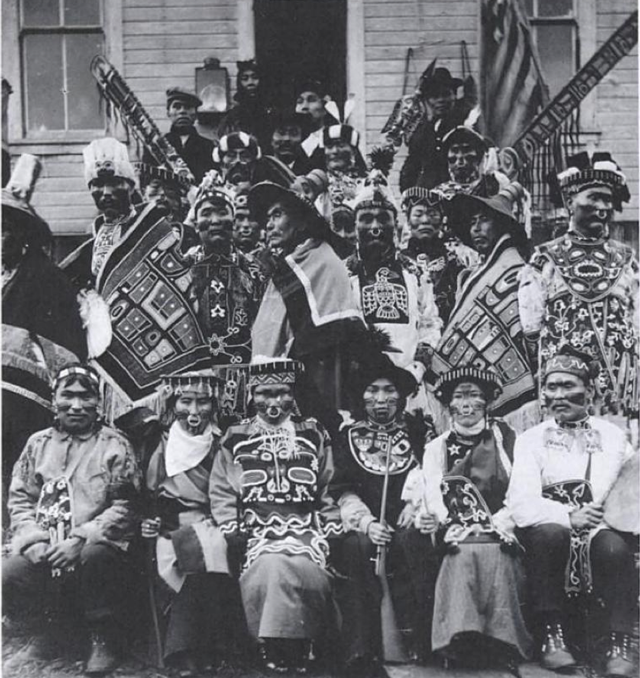 |
|
Tlingit potlatch guests displaying their status symbols and arranged by rank. Every piece of decorative clothing, every hat, every design every piece of jewelry and every item held in the hand is inheritated and my only be displayed by high ranking individuals. Sitka, Alaska. Taken by E.W. Merrill in th early 1900s. |
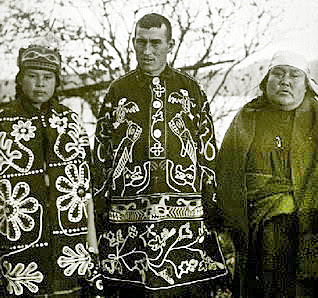 |
Charles James Newell (center) with his mother (right) and wife (left) photographed in 1899 at 'Yalis, British Columbia. His father was white and of relatively high status, but His mother is a commoner. Even though he had sufficient wealth to dress his mother in high quality clothing, he could not do so because her rank and status in society, which is inherited, does not give her this right. On the other hand, his wife, who is the daughter of Chief Lageuse, is appropriately atired for her rank in society, while his attire and his wife reflect his position in society. |
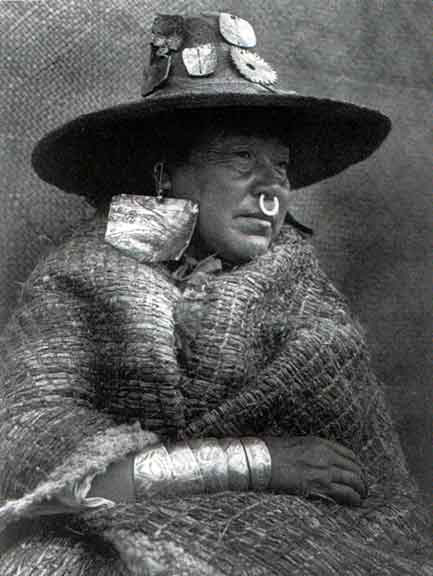 |
Tsukwani, aka Francine Hunt, the second wife of George Hunt, photographed in 1914. Notice the abalone, silver bracelets and nose ring, which are all symbols of her high status. |
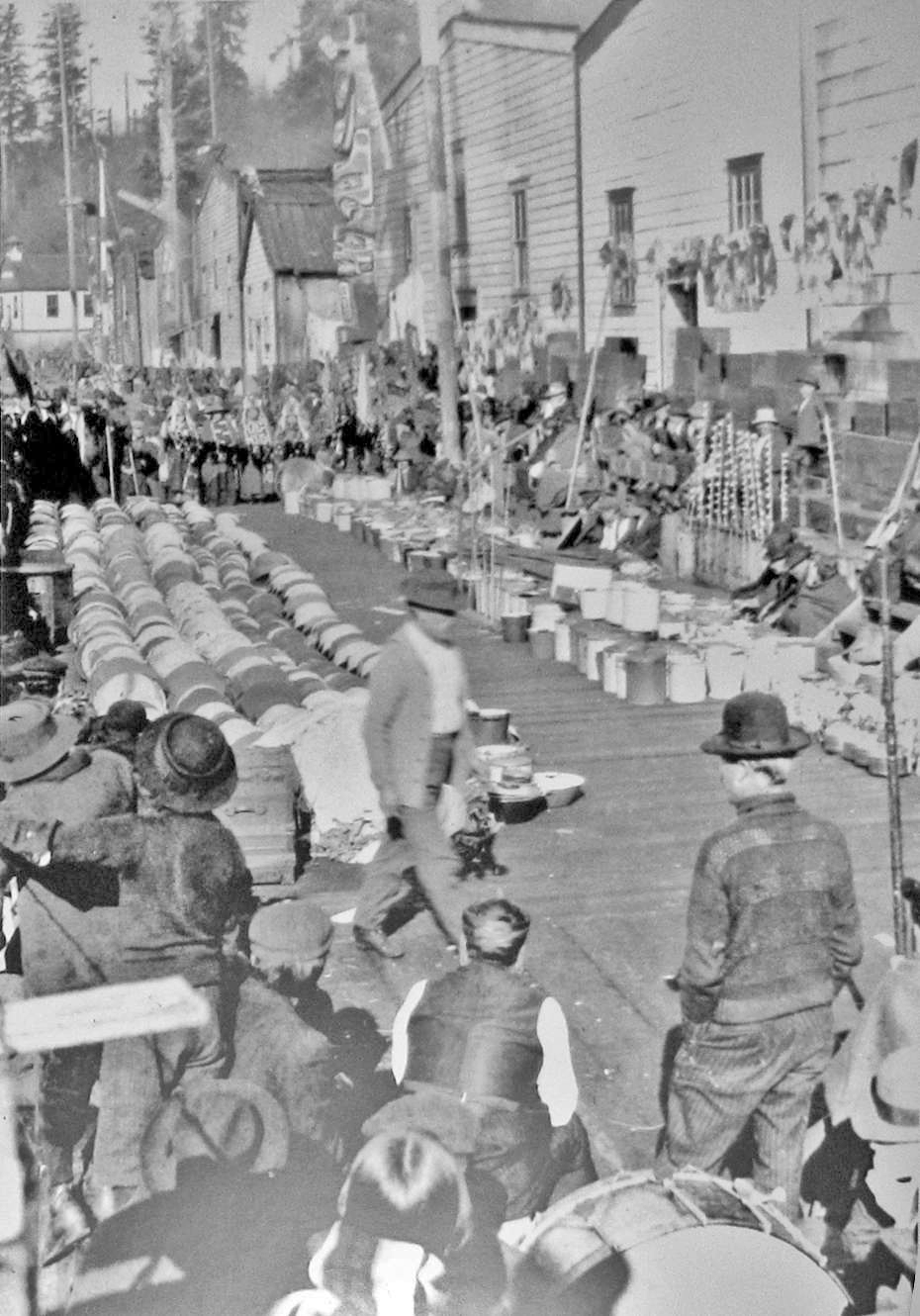
|
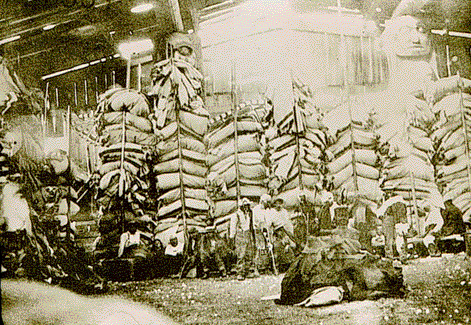 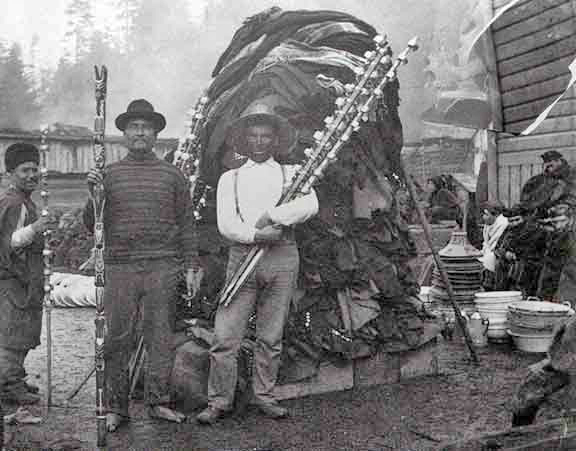
|
|
Status and rank were supported by the Potlatch system. The Chief of a lineage would hold a potlatch, often as part of the winter ceremonials, in which he would give away all the property that he controlled to a number of other lineages that were invited to attend. Huge amounts of goods were distributed according to status and rank. For examples, the blankets you see above might be given to everyone, including commoners, but the silver bracelets were reserved for individuals of higher states. How much you received and what you received, depended on your rank and status. At the culmination of the Potlatch, a copper might be given to a rival Chief. In this case, the rival Chief was obligated to hold a Potlatch in which he distributed twice the number of goods given away or destroyed at the time he received the copper. After a while, coppers became so valuable that no Chief could afford to receive them. This is when the copper was symbolically destroyed by the Hamatsa society initiate at the culmination of the ceremonial dance cycle in which the spirit of Cannibal Woman is contained. | |
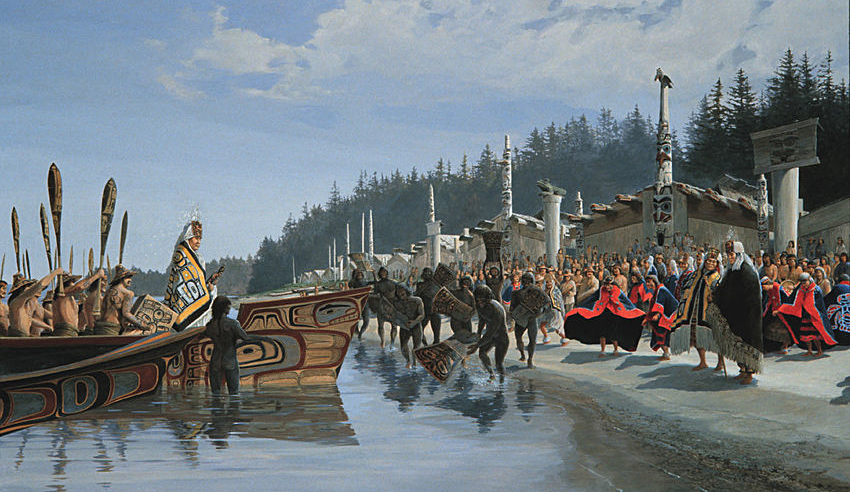
|
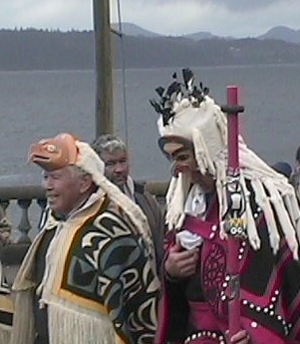
|
|
At the left, a lineage Chief and party are greeted by a Haida Chief and his lineage at the beginning of a potlatch. Notice the coppers that are being displayed to impress the visiting Chief. At the right, a Haida Chief and his Speaker arrive at Alert Bay. The Chief wares a forehead mask so that his face remains visible, but his speaker wares a face mask since it is not his face that is important. Rather, his costume marks him as an important, high-status perseon, and his staff marks him as the Chief's speaker. | |
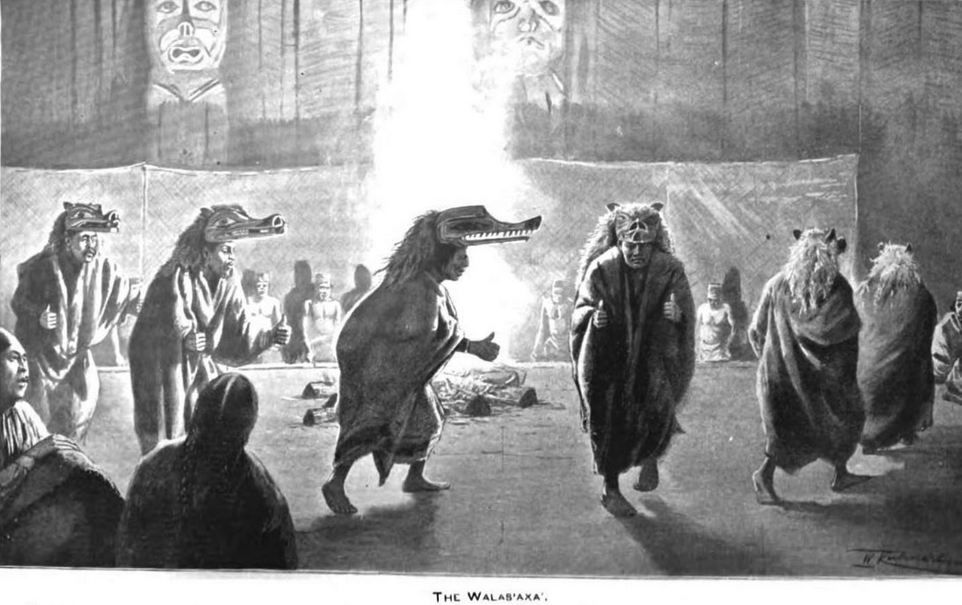 |
|
The Walas'aka, or Wolf Secret Society, dancing during at a potlatch. The Walas'aka are among the Que'qutsa, helpers of the Hamatsa. Here we see as envisioned by Boas (1895). |
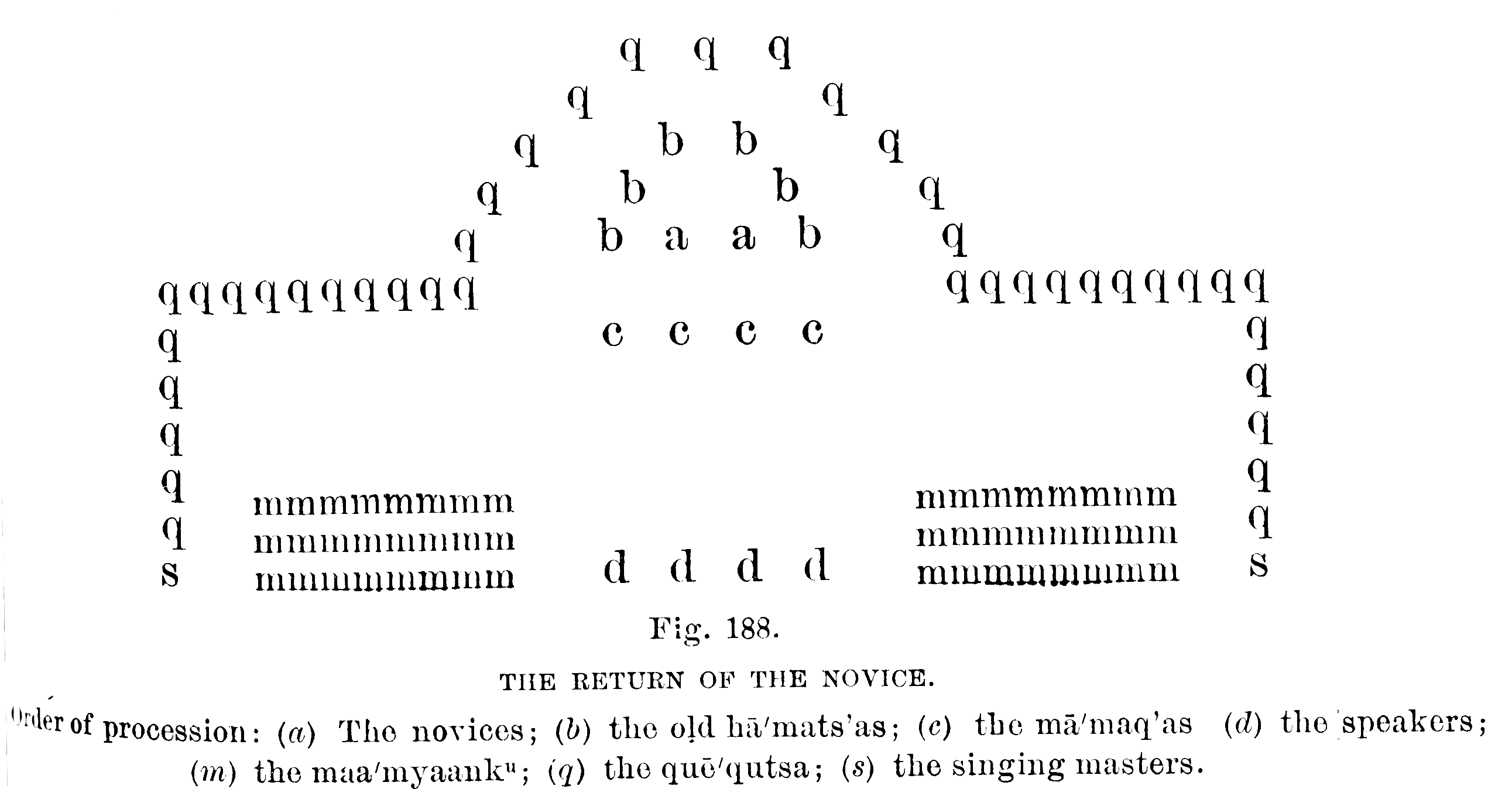 |
|
Potlatches are complex affairs and outsiders are not allowed to participate. Thus, there are very few explicitly described potlatches. This is one described by George Hunt, a Kwakiutl who worked closely with Boas. Here we see just one scene in whitch the initiates (a) have returned to the long house after escaping. "C" are the leaders of the ritual and "d" are their speakers. Formar initiates are "b" and "q" are all the helpers, including those from the Wolf Secret Society pictured above. "s" are to singing masters and "m" are observing participants divided into local and invited dignitaries. Here's how the drama unfolds ... |
 

|

|
|
Breaking the copper. | |
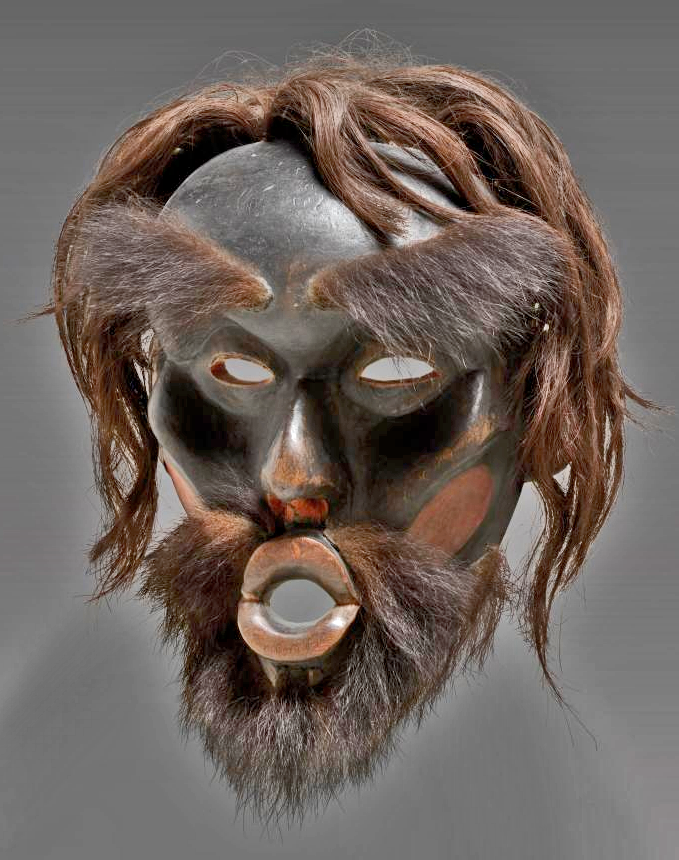
|
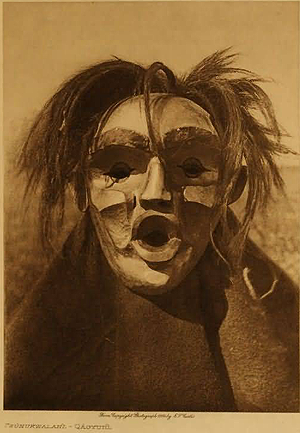
|
|
Breaking the copper banishes only one manifestation of Cannibal Woman. The Chief, whose copper has been broken, also has the right to take on another aspect of Cannibal Woman, that of the bringer of wealth and good fortune. Unlike the Hamatsa initiate, the Chief's mask (gikamhl) has eye holes that permit him to see. He may wear the mask when distributing goods to those participating in the Potlatch and also at the end of the Potlatch when the broken copper is presented to its next owner. Above are two examples of this kind of mask. At the left is a mask dating from about 1870, now in the British Museum. At the right is a photo taken by Curtis in 1914 showing what such a mask would look like when worn. | |
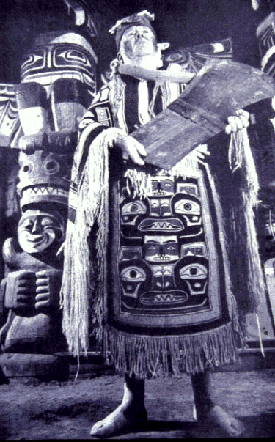 |
Chief displaying a broken copper. Note the cendar ring he wears, marking him as a member of the Hamatsa society. |
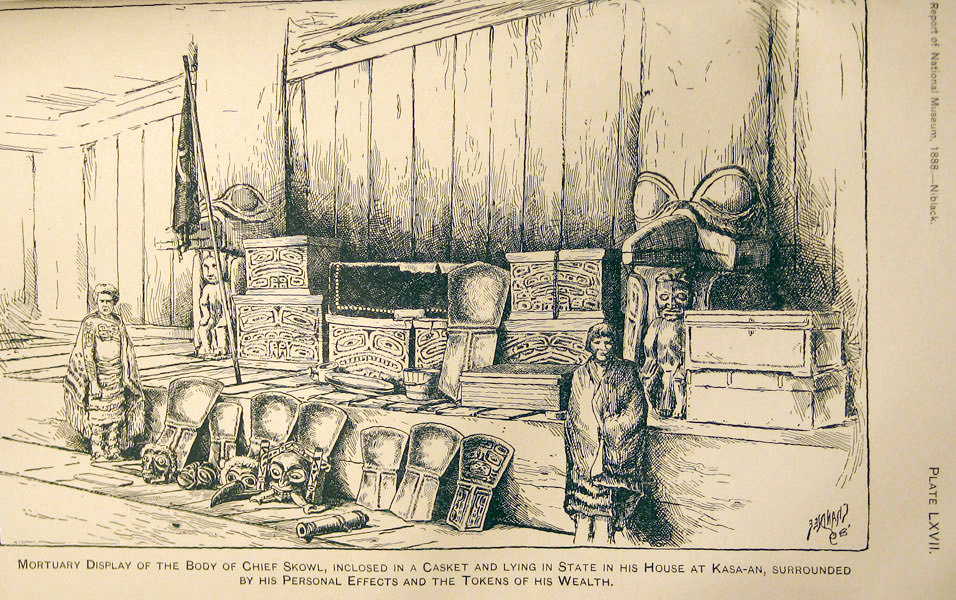 |
|
The coffin, center black, of Chief Skowl on the dias at the front of his long house, surrounded by his most important possessions. Note the eight coppers, together with his most important masks and a cannon. Skowl, a Haida, was Chief of seven lineages that situated their lineage great houses at Kasaan, on Skowl Bay, Alaska. He died in the winter of 1882. |
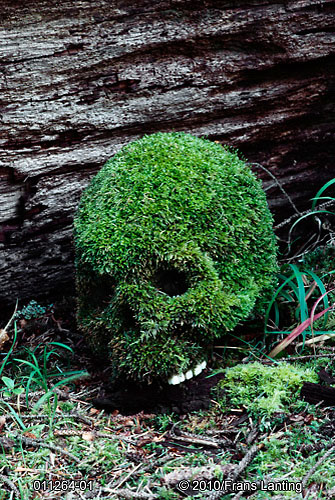 |
|
|
Text & layout © 2010, 2017, 2019 by Charles M. Nelson
all rights reserved
